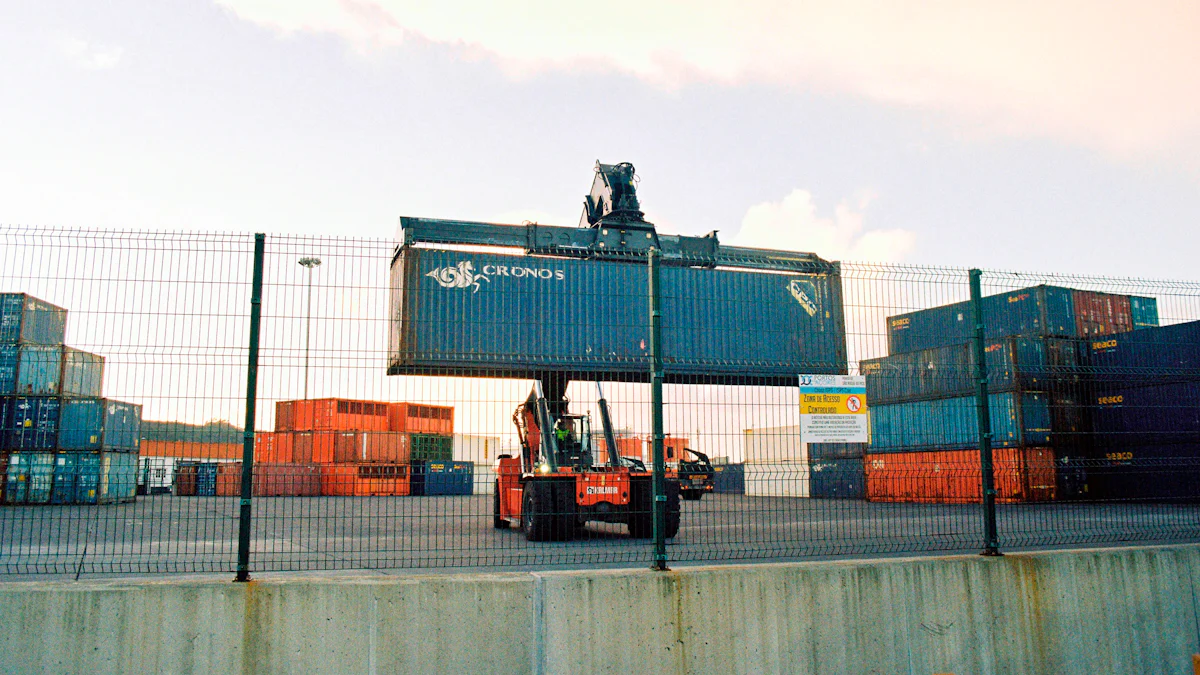Key Approaches for Logistics Operations in the Second Half of 2024

Logistics operations play a crucial role in the global economy. The logistics market is expected to reach $6.55 trillion by 2027, highlighting its growing importance. Emerging trends in 2024 emphasize automation, labor shortages, and real-time tracking to enhance supply chain management. Sustainable logistics will shift from an environmental imperative to a key economic success factor. Innovative approaches will be essential in the second half of 2024 to navigate these challenges and capitalize on new opportunities.
Technological Advancements in Logistics Operations

Automation and Robotics in Logistics Operations
Benefits of automation in logistics
Automation brings many benefits to logistics operations. Automated systems streamline warehouse operations, leading to faster delivery times and lower operational costs. Companies can optimize route planning and enhance inventory management through automation. This results in improved efficiency and reduced errors. Automation also helps address labor shortages by improving worker productivity. A survey from Descartes found that 54% of logistics companies are automating tasks to boost productivity and reduce worker dissatisfaction.
Key technologies to watch
Several key technologies are transforming logistics operations. Robotics plays a significant role in automating repetitive tasks in warehouses. Amazon, for example, uses over 750,000 robots across its facilities. These robots help increase productivity and cut costs. Freight automation software is another technology to watch. This software optimizes supply chain processes, reshaping global logistics. Companies should also keep an eye on automated systems for parcel sorting and customer service. These systems promise faster deliveries and better service quality.
Artificial Intelligence and Machine Learning in Logistics Operations
Predictive analytics for demand forecasting
Artificial Intelligence (AI) revolutionizes logistics operations with predictive analytics. AI can forecast demand more accurately than traditional methods. This helps companies manage inventory levels and reduce stockouts. AI-driven predictive analytics also improves supply chain efficiency. By analyzing historical data, AI can predict future trends and adjust logistics strategies accordingly. This leads to better decision-making and increased profitability.
AI-driven route optimization
AI-driven route optimization enhances logistics operations by finding the most efficient routes for deliveries. This reduces transit times and fuel consumption. AI can analyze traffic patterns, weather conditions, and other factors to optimize routes in real-time. This results in faster deliveries and lower operational costs. AI-driven route optimization also improves customer satisfaction by ensuring timely deliveries. Companies using AI for route optimization see significant improvements in efficiency and service quality.
Internet of Things (IoT) in Logistics Operations
Real-time tracking and monitoring
The Internet of Things (IoT) enables real-time tracking and monitoring in logistics operations. IoT devices provide real-time data on the location and condition of goods. This helps companies monitor shipments and ensure timely deliveries. Real-time tracking also reduces the risk of lost or damaged goods. Companies can use IoT data to improve supply chain visibility and make informed decisions. This leads to better inventory management and increased efficiency.
Enhancing supply chain visibility
IoT enhances supply chain visibility by providing real-time data on every aspect of logistics operations. Companies can track shipments from start to finish, ensuring transparency and accountability. IoT devices also monitor environmental conditions, such as temperature and humidity, during transit. This helps companies maintain the quality of perishable goods. Enhanced supply chain visibility leads to better decision-making and improved customer satisfaction. Companies using IoT in logistics operations see significant improvements in efficiency and service quality.
Sustainable Practices in Logistics Operations

Green Logistics
Reducing carbon footprint
Green logistics focuses on reducing the carbon footprint of logistics operations. Companies can achieve this by adopting electric vehicles for transportation. Electric vehicles produce zero emissions, making them an eco-friendly alternative to traditional diesel trucks. Renewable energy sources also play a crucial role. Solar panels and wind turbines can power warehouses and distribution centers. This shift reduces reliance on fossil fuels and lowers greenhouse gas emissions.
Another effective strategy involves optimizing delivery routes. Route optimization software minimizes travel distance and fuel consumption. This not only cuts costs but also reduces emissions. Companies like UPS have implemented such systems successfully. The result is a significant reduction in their carbon footprint.
Eco-friendly packaging solutions
Eco-friendly packaging solutions are essential for sustainable logistics operations. Companies can use biodegradable materials for packaging. These materials break down naturally, reducing waste in landfills. Recycled materials also offer a sustainable option. Packaging made from recycled paper or plastic reduces the need for new raw materials.
Innovative designs can further enhance sustainability. Packaging that uses less material without compromising protection helps reduce waste. Companies can also implement reusable packaging systems. For example, some businesses use returnable containers for shipping goods. This practice reduces the need for single-use packaging and promotes sustainability.
Circular Economy
Recycling and reusing materials
The circular economy model emphasizes recycling and reusing materials. This approach contrasts with the traditional linear model, which focuses on production, use, and disposal. In logistics operations, companies can recycle packaging materials. Reusing pallets and containers also contributes to sustainability. This practice reduces waste and conserves resources.
Companies can implement take-back programs for used products. These programs encourage customers to return items for recycling or refurbishment. This not only reduces waste but also extends the life cycle of products. For instance, electronics manufacturers often use this approach to manage e-waste.
Waste reduction strategies
Waste reduction strategies are vital for sustainable logistics operations. Companies can start by conducting waste audits. These audits identify areas where waste occurs and provide insights for improvement. Implementing lean manufacturing principles can also help. Lean practices focus on minimizing waste and maximizing efficiency.
Another strategy involves using digital tools for inventory management. Accurate inventory tracking reduces overstock and minimizes waste. Companies can also partner with organizations that specialize in waste management. These partnerships ensure proper disposal and recycling of materials.
Case Studies:
Adopting Green Logistic Solutions: Manufacturers focusing on green logistic solutions and ESG policies have seen benefits. Lower fuel costs and appeal to eco-conscious consumers are notable outcomes.
Sustainability Trends in Logistics: Key trends include electric vehicles, renewable energy adoption, and eco-friendly packaging. These trends address environmental concerns and meet consumer demands.
Workforce Management in Logistics Operations
Training and Development
Upskilling for new technologies
Logistics operations increasingly rely on advanced technologies. Workers need upskilling to keep pace with these changes. Companies must invest in training programs focused on new technologies. Employees who understand automation, AI, and IoT can improve logistics efficiency. A survey revealed that 30% of respondents felt dissatisfied with their organization's training investments. Addressing this gap can enhance workforce satisfaction.
Upskilling also prepares employees for future roles. The logistics sector evolves rapidly. Workers equipped with the latest skills can adapt more easily. This adaptability benefits both the employees and the organization. Continuous learning should become a core part of logistics operations.
Safety and compliance training
Safety and compliance remain critical in logistics operations. Proper training ensures that employees follow regulations and maintain safety standards. Companies must provide regular safety training sessions. These sessions should cover the latest industry regulations and best practices.
Compliance training helps avoid legal issues. Employees aware of compliance standards can prevent costly violations. Regular updates on safety protocols keep the workforce informed. This proactive approach reduces workplace accidents and enhances overall safety. Effective safety and compliance training contribute to a safer work environment.
Employee Retention
Incentive programs
Employee retention poses a significant challenge in logistics operations. Incentive programs can help address this issue. Offering bonuses and rewards motivates employees to stay with the company. Financial incentives recognize hard work and dedication.
Non-monetary incentives also play a role. Recognition programs highlight employee achievements. Public acknowledgment boosts morale and fosters loyalty. Providing career advancement opportunities keeps employees engaged. When workers see a clear path for growth, they are more likely to remain with the company.
Work-life balance initiatives
Work-life balance initiatives improve employee retention in logistics operations. Flexible working hours allow employees to manage personal and professional responsibilities. Remote work options can also enhance work-life balance.
Offering wellness programs supports employee well-being. Programs focusing on mental and physical health reduce stress levels. Healthier employees are more productive and satisfied with their jobs. Encouraging a healthy work-life balance creates a positive work environment. This approach leads to higher retention rates and a more committed workforce.
Strategic Partnerships in Logistics Operations
Collaborations with Tech Firms
Integrating new technologies
Collaborations with tech firms can revolutionize logistics operations. Companies like DHL have partnered with Locus Robotics to improve efficiency and reduce errors. These partnerships enable the integration of cutting-edge technologies into daily operations. Automated systems streamline processes, making logistics operations more efficient.
Tech firms provide expertise in areas like AI and IoT. Logistics companies can leverage this knowledge to enhance their capabilities. For example, integrating AI-driven software can optimize route planning and inventory management. This leads to faster deliveries and lower operational costs. IoT devices offer real-time tracking and monitoring, improving supply chain visibility.
Joint ventures for innovation
Joint ventures with tech firms foster innovation in logistics operations. Penske and Ford's Network Integrator concept showcases the potential of such collaborations. This initiative saved over 25 million truck kilometers and reduced CO2 emissions by more than 10,000 tons annually. Joint ventures encourage the development of new solutions that address industry challenges.
These partnerships also promote knowledge sharing. Logistics companies gain insights into emerging technologies and trends. This helps them stay competitive in a rapidly evolving market. Joint ventures create opportunities for co-development of innovative products and services. This collaboration drives progress and enhances logistics operations.
Third-Party Logistics (3PL) Providers
Benefits of outsourcing
Outsourcing logistics operations to Third-Party Logistics (3PL) providers offers numerous benefits. 3PL providers specialize in managing logistics functions, allowing companies to focus on their core business. This leads to increased efficiency and cost savings. Logistics alliances can lower distribution and storage operating costs, improving overall profitability.
3PL providers bring expertise and resources that enhance logistics operations. They offer advanced technology solutions, such as automated systems and real-time tracking. This improves supply chain visibility and reduces errors. Outsourcing logistics operations also provides flexibility. Companies can scale their logistics services based on demand, ensuring optimal resource utilization.
Selecting the right 3PL partner
Choosing the right 3PL partner is crucial for successful logistics operations. Companies should evaluate potential partners based on their expertise and capabilities. A good 3PL provider should have a proven track record in managing logistics functions. They should also offer advanced technology solutions that align with the company's needs.
Customer service quality is another important factor. Logistics alliances can improve the quality of customer service, enhancing customer satisfaction. Companies should look for 3PL providers that prioritize customer service and have robust support systems. Cost-effectiveness is also essential. The right 3PL partner should offer competitive pricing without compromising on service quality.
The blog explored key approaches for logistics operations in the second half of 2024. Companies must adopt cutting-edge technologies like AI, IoT, and automation. Sustainable practices, such as green logistics and circular economy models, are essential. Effective workforce management and strategic partnerships also play a crucial role.
Staying adaptable and innovative is vital. The logistics industry faces rapid changes and new challenges. Companies that embrace innovation will thrive. The future of logistics operations looks promising with advancements in technology and sustainability.
See Also
Best 5 Logistics Courses for 2024
Artificial Intelligence in Supply Chain: Transforming Future Logistics
Advancements in Logistics Technology: Exploring Future Innovations
Understanding the Influence: Trends in Logistics Risks
Revealing Logistics Cost Savings: Expert Tips for Efficient Supply Chains
